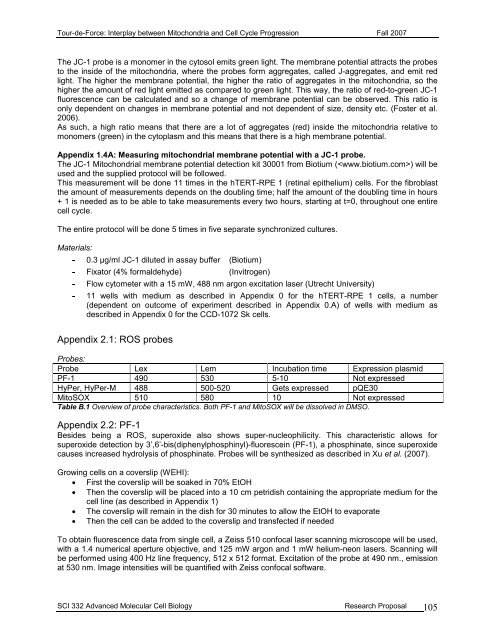Tour-de-Force
Tour-de-Force
Tour-de-Force
You also want an ePaper? Increase the reach of your titles
YUMPU automatically turns print PDFs into web optimized ePapers that Google loves.
<strong>Tour</strong>-<strong>de</strong>-<strong>Force</strong>: Interplay between Mitochondria and Cell Cycle Progression Fall 2007The JC-1 probe is a monomer in the cytosol emits green light. The membrane potential attracts the probesto the insi<strong>de</strong> of the mitochondria, where the probes form aggregates, called J-aggregates, and emit redlight. The higher the membrane potential, the higher the ratio of aggregates in the mitochondria, so thehigher the amount of red light emitted as compared to green light. This way, the ratio of red-to-green JC-1fluorescence can be calculated and so a change of membrane potential can be observed. This ratio isonly <strong>de</strong>pen<strong>de</strong>nt on changes in membrane potential and not <strong>de</strong>pen<strong>de</strong>nt of size, <strong>de</strong>nsity etc. (Foster et al.2006).As such, a high ratio means that there are a lot of aggregates (red) insi<strong>de</strong> the mitochondria relative tomonomers (green) in the cytoplasm and this means that there is a high membrane potential.Appendix 1.4A: Measuring mitochondrial membrane potential with a JC-1 probe.The JC-1 Mitochondrial membrane potential <strong>de</strong>tection kit 30001 from Biotium () will beused and the supplied protocol will be followed.This measurement will be done 11 times in the hTERT-RPE 1 (retinal epithelium) cells. For the fibroblastthe amount of measurements <strong>de</strong>pends on the doubling time; half the amount of the doubling time in hours+ 1 is nee<strong>de</strong>d as to be able to take measurements every two hours, starting at t=0, throughout one entirecell cycle.The entire protocol will be done 5 times in five separate synchronized cultures.Materials:0.3 µg/ml JC-1 diluted in assay buffer (Biotium)Fixator (4% formal<strong>de</strong>hy<strong>de</strong>)(Invitrogen)Flow cytometer with a 15 mW, 488 nm argon excitation laser (Utrecht University)11 wells with medium as <strong>de</strong>scribed in Appendix 0 for the hTERT-RPE 1 cells, a number(<strong>de</strong>pen<strong>de</strong>nt on outcome of experiment <strong>de</strong>scribed in Appendix 0.A) of wells with medium as<strong>de</strong>scribed in Appendix 0 for the CCD-1072 Sk cells.Appendix 2.1: ROS probesProbes:Probe Lex Lem Incubation time Expression plasmidPF-1 490 530 5-10 Not expressedHyPer, HyPer-M 488 500-520 Gets expressed pQE30MitoSOX 510 580 10 Not expressedTable B.1 Overview of probe characteristics. Both PF-1 and MitoSOX will be dissolved in DMSO.Appendix 2.2: PF-1Besi<strong>de</strong>s being a ROS, superoxi<strong>de</strong> also shows super-nucleophilicity. This characteristic allows forsuperoxi<strong>de</strong> <strong>de</strong>tection by 3’,6’-bis(diphenylphosphinyl)-fluorescein (PF-1), a phosphinate, since superoxi<strong>de</strong>causes increased hydrolysis of phosphinate. Probes will be synthesized as <strong>de</strong>scribed in Xu et al. (2007).Growing cells on a coverslip (WEHI):• First the coverslip will be soaked in 70% EtOH• Then the coverslip will be placed into a 10 cm petridish containing the appropriate medium for thecell line (as <strong>de</strong>scribed in Appendix 1)• The coverslip will remain in the dish for 30 minutes to allow the EtOH to evaporate• Then the cell can be ad<strong>de</strong>d to the coverslip and transfected if nee<strong>de</strong>dTo obtain fluorescence data from single cell, a Zeiss 510 confocal laser scanning microscope will be used,with a 1.4 numerical aperture objective, and 125 mW argon and 1 mW helium-neon lasers. Scanning willbe performed using 400 Hz line frequency, 512 x 512 format. Excitation of the probe at 490 nm., emissionat 530 nm. Image intensities will be quantified with Zeiss confocal software.SCI 332 Advanced Molecular Cell Biology Research Proposal 105
















